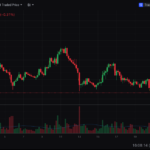Crypto markets are bleeding again. Bitcoin is down double digits, altcoins are in free fall, and fear is spreading fast.
But what’s actually causing this crash?
And more importantly — how are smart traders reacting?
Let’s break it down.
📉 The Main Reasons Behind the Crypto Crash
Crypto rarely crashes without cause. Here are the most likely catalysts driving the current sell-off:
1. Macroeconomic Pressure
High inflation, interest rate uncertainty, and tightening monetary policy globally have made risk assets — including crypto — vulnerable.
Even a whisper from the Fed can spark a sharp pullback.
2. Regulatory Headlines
Uncertainty around crypto ETFs, SEC crackdowns, or rumors of restrictions (like a ban in China or negative stance from the EU) always shake investor confidence.
Fear of legal pressure = people rush for the exit.
3. Liquidations and Overleverage
When the market goes up fast, traders pile in with leverage. When it drops, mass liquidations hit:
- Cascading stop-losses
- Margin calls
- Automated sell-offs from exchanges
This can amplify a 5% drop into a full-blown crash.
4. Whale Movements and Panic
A few large wallets moving BTC or ETH to exchanges can trigger massive sell pressure. Add Twitter panic and Reddit threads, and the snowball grows.
🧠 What Smart Traders Are Doing Right Now
While many are panicking, experienced traders follow a playbook:
✅ 1. Zoom Out & Look at the Weekly Chart
One-day red candles don’t define long-term trends. Pros look at support zones, volume levels, and trendlines on higher timeframes.
✅ 2. Deploy Capital Strategically
They don’t “buy the dip” randomly — they DCA (dollar-cost average) into strong projects near key levels with stop-losses in place.
✅ 3. Rotate Into Stablecoins
Smart traders exit altcoins early and hold USDT/USDC while watching the chaos. Sometimes the best trade is no trade.
✅ 4. Hedge With Options or Inverse Assets
Traders use put options, short tokens, or inverse ETFs (where available) to protect their portfolios.
✅ 5. Watch On-Chain Metrics
They monitor:
- Exchange inflows/outflows
- Whale wallets
- DeFi liquidations
to anticipate bottoms.
🧭 Final Thought: Crashes Create Clarity
Yes, it’s painful. But corrections are also where:
- Weak hands sell
- Real conviction is tested
- Life-changing entry points appear
Don’t just survive the crash — study it, learn from it, and prepare for the next wave.







